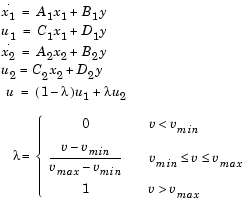

| Aerospace Blockset |   |
Implement a 1-D vector of state-space controllers by linear interpolation of their outputs
Library
Description
The 1D Controller Blend u=(1-L).K1.y+L.K2.y block implements an array of state-space controller designs. The controllers are run in parallel, and their outputs interpolated according to the current flight condition or operating point. The advantage of this implementation approach is that the state-space matrices A, B, C, and D for the individual controller designs do not need to vary smoothly from one design point to the next.
For example, suppose two controllers are designed at two operating points v=vmin and v=vmax. The 1D Controller Blend block implements

For longer arrays of design points, the blocks only implement nearest neighbor designs. For the 1D Controller Blend block, at any given instant in time, three controller designs are being updated. This reduces computational requirements.
As the value of the scheduling parameter varies and the index of the controllers that need to be run changes, the states of the oncoming controller are initialized by using the self-conditioned form as defined for the Self-Conditioned [A,B,C,D] block.
Dialog Box
Inputs and Outputs
The first input is the measurements.
The second input is the scheduling variable conforming to the dimensions of the state-space matrices.
The output is the actuator demands.
Assumptions and Limitations
This block requires the Control Systems Toolbox.
Examples
See the autopilot in the aeroblk_HL20.mdl demo for an example of this block in use.
References
Hyde, R.A., "H-infinity Aerospace Control Design - A VSTOL Flight Application," Springer Verlag, Advances in Industrial Control Series, 1995. ISBN 3-540-19960-8. See Chapter 5.
See Also
1D Controller [A(v),B(v),C(v),D(v)]
1D Observer Form [A(v),B(v),C(v),F(v),H(v)]
1D Self-Conditioned [A(v),B(v),C(v),D(v)]
 | 1D Controller [A(v),B(v),C(v),D(v)] | 1D Observer Form [A(v),B(v),C(v),F(v),H(v)] |  |